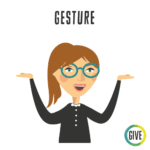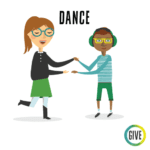Give Peace a Chance
Contribution de T. Scott Lilly
![]()
![]()
![]()
Description
This brain-break activity will help students to center their focus, and encourage them to express their feelings, as you set out to build your community inspired by a tune from John Lennon.
instructions
- Start in a circle.
- Teach the refrain of the John Lennon song “Give Peace a Chance”
- call-and-response style. “All we are saying is give peace a chance.”
- “Next we all hum the melody of the refrain without the words.”
- “Now we will go back and forth between singing it and humming it (over and over).”
- “During the humming part, each of us, one at a time, will have a turn to say something about peace, or how we’re feeling, or what’s on our minds. You could do anything at all, as long as it’s safe for all and you’re done by time we all sing again.”
- “Here are some ideas:
- tell us how you’re feeling or what’s on your mind;
- do a dance routine;
- sing scat;
- perform a magic trick;
- do a stretch, etc.”
- “Here are some ideas:
- One at a time, go around the circle clockwise. Model this with Classroom Professionals, showing a variety of things you can do. Or have all the students do one specific thing.
- When you’ve come full circle, sing one last time with gusto, strike a pose, and yell, “A’ho!” which means “Yes, I agree!” in Lakota. Use any other words to bring the class into unity.
- Extension and advanced options that can be taught with this activity, but don’t have to be:
- The refrain of the song takes four measures of four beats—16 beats. There’s a “pick up” to it. You come in after two beats on the 3rd beat.
- Use dynamics: soft, loud, staccato, legato (don’t speed up or slow down).
- Step in time. Step side to side. Clap on the second and fourth beat.
- Add gestures. Create choreography.
Transition vers l'activité
Transition hors de l'activité
Take a moment to acknowledge the students and Classroom Professionals’ bravery and the community that we are building together.
Aménagement de la salle de classe
This is ideally done in a room with enough space for a circle. It can be adapted for any space situation. You will need a different turn-taking instruction or mechanism for choosing the next student if they are not in a circle.
Supports/Matériaux adaptatifs/Outils
- Model what is being asked of the students before you ask them to complete a task.
- Show a variety of things you could do during a turn before they start.
- Make a written list and/or provide vocabulaire visuel on the board for students to reference.
- Invite everyone to try one specific thing that the group chooses before you start.
- Try starting with a theme for the humming breaks. Some examples could be: your favorite dessert and why, the best part of your day, or the worst part of your day.
Rôle des professionnels de la classe
- Participate in the lesson.
- Encourage students and bring enthusiasm.
Réglages pour l'instruction à distance
![]()
This could be done with accurate control of muting and unmuting. When it’s the student’s turn to do something during the humming part, they unmute themselves. Otherwise, we remain muted except for the leader, who keeps the melody going. Students are expected to be singing and humming even though we cannot hear them.



